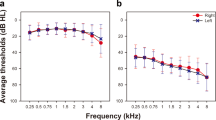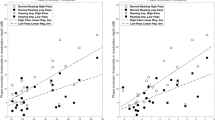Abstract
The aim of the article was to compare the conditions of silent and contralateral noise on the temporal processing parameters. A total of 40 participants (20 males and 20 females) were enrolled in the study with a mean age of 21.7 years, participants with normal hearing thresholds and no history of middle ear pathology were enrolled for the study. The temporal processing tests such as duration discrimination test, gap detection test, and temporal modulation transfer function tests were carried out in these 40 individuals in the two conditions of silent and contralateral noise using MATLAB. Statistical analysis was carried out using the SPSS version 25.0 were descriptive and inferential statistics were carried out. Data was normally distributed on the Shapiro–Wilk’s test of normality due to which a paired t test was carried out to establish the nature of significance between the silent and contralateral noise condition. Results reveal the presence of significant difference (p < 0.01) between the groups for all the parameters of temporal resolution with contralateral noise condition performing better than silent condition for the parameters. There is a positive effect of the efferent auditory pathway on the temporal resolution parameters thus implying that speech perception in noise is improved in the presence of background noise for normal hearing individuals due to this effect.



Similar content being viewed by others
References
Hill JC, Prasher DK, Luxon LM (1997) Evidence for efferent effects on auditory afferent activity, and their functional relevance. Clin Otolaryngol Allied Sci 22(5):394–402
Berlin CI, Hood LJ, Ricci A (eds) (2002) Hair cell micromechanics and otoacoustic emissions. Delmar Learning, New York
Murugasu E, Russell IJ (1996) The effect of efferent stimulation on basilar membrane displacement in the basal turn of the guinea pig cochlea. J Neurosci 16(1):325–332
Galambos R (1956) Suppression of auditory nerve activity by stimulation of efferent fibers to cochlea. J Neurophysiol 19(5):424–437
Fex J (1959) Augmentation of cochlear microphonic by stimulation of efferent fibres to the cochlea; preliminary report. Acta Otolaryngol 50:540–541
Puel JL, Rebillard G (1990) Effect of contralateral sound stimulation on the distortion product 2 F 1− F 2: evidence that the medial efferent system is involved. J Acoust Soc Am 87(4):1630–1635
Giraud AL, Collet L, Chéry-Croze S, Magnan J, Chays A (1995) Evidence of a medial olivocochlear involvement in contralateral suppression of otoacoustic emissions in humans. Brain Res 705(1–2):15–23
Guinan JJ, Backus BC, Lilaonitkul W, Aharonson V (2003) Medial olivocochlear efferent reflex in humans: otoacoustic emission (OAE) measurement issues and the advantages of stimulus frequency OAEs. J Assoc Res Otolaryngol 4(4):521–540
Burguetti FAR, Carvallo RMM (2008) Efferent auditory system: its effect on auditory processing. Revista Brasileira de Otorrinolaringologia 74:737–745
Dolan DF, Guo MH, Nuttall AL (1997) Frequency-dependent enhancement of basilar membrane velocity during olivocochlear bundle stimulation. J Acoust Soc Am 102(6):3587–3596
Quaranta N, Scaringi A, Nahum S, Quaranta A (2005) Effects of efferent acoustic reflex activation on psychoacoustical tuning curves in humans. Acta Otolaryngol 125(5):520–523
Giraud AL, Garnier S, Micheyl C, Lina G, Chays A, Chéry-Croze S (1997) Auditory efferents involved in speech-in-noise intelligibility. NeuroReport 8(7):1779–1783
Kumar UA, Vanaja CS (2004) Functioning of olivocochlear bundle and speech perception in noise. Ear Hear 25(2):142–146
Mertes IB, Johnson KM, Dinger ZA (2019) Olivocochlear efferent contributions to speech-in-noise recognition across signal-to-noise ratios. J Acoust Soc Am 145(3):1529–1540
Wagner W, Frey K, Heppelmann G, Plontke SK, Zenner HP (2008) Speech-in-noise intelligibility does not correlate with efferent olivocochlear reflex in humans with normal hearing. Acta Otolaryngol 128(1):53–60
Yashaswini L, Maruthy S (2019) The influence of efferent inhibition on speech perception in noise: A revisit through its level-dependent function. Am J Audiol 28(2S):508–515
Giraud AL, Collet L, Chéry-Croze S (1997) Suppression of otoacoustic emission is unchanged after several minutes of contralateral acoustic stimulation. Hear Res 109(1–2):78–82
Müller J, Janssen T, Heppelmann G, Wagner W (2005) Evidence for a bipolar change in distortion product otoacoustic emissions during contralateral acoustic stimulation in humans. J Acoust Soc Am 118(6):3747–3756
van Zyl A, Swanepoel D, Hall III JW (2009) Effect of prolonged contralateral acoustic stimulation on transient evoked otoacoustic emissions
Delphi M, Tahaei SAA (2010) The effect of contralateral noise stimulation on difference limen for intensity. Bimonthly Audiol Tehran Univ Med Sci 19(1):50–56
Carmichael ME, Hall SE, Phillips DP (2008) Ear and contralateral masker effects on auditory temporal gap detection thresholds. Hear Res 245(1–2):18–23
Moore BC (2014) Auditory processing of temporal fine structure: Effects of age and hearing loss. World Scientific, Singapore
Carhart R, Jerger JF (1959) Preferred method for clinical determination of pure-tone thresholds. J Speech Hear Disord 24(4):330–345
Yathiraj A, Vijayalakshmi CS (2005) Phonemically balanced word list in Kannada: developed in department of audiology. AIISH, Mysore
Schwartz J, Tallal P (1980) Rate of acoustic change may underlie hemispheric specialization for speech perception. Science 207(4437):1380–1381
Creese I (1999) Rate processing constraints may underlie developmental language impairments and also hemispheric specialization for speech. Brain Res Bull 50(5–6):431–432
Lorenzi C, Wable J, Moroni C, Derobert C, Frachet B, Belin C (2000) Auditory temporal envelope processing in a patient with left-hemisphere damage. Neurocase 6(3):231–244
Grassi M, Soranzo A (2009) MLP: a MATLAB toolbox for rapid and reliable auditory threshold estimation. Behav Res Methods 41(1):20–28
Green DM (1990) Stimulus selection in adaptive psychophysical procedures. J Acoust Soc Am 87(6):2662–2674
Green DM (1993) A maximum-likelihood method for estimating thresholds in a yes–no task. J Acoust Soc Am 93(4):2096–2105
Prakash P, Jayan A, Prabhu P (2021) Effects of diurnal changes on temporal processing in morning-type and evening-type individuals with normal hearing. Eur Arch Oto-Rhino-Laryngol 1–7
Nie NH, Bent DH, Hull CH (1975) SPSS: Statistical package for the social sciences, vol 227. McGraw-Hill, New York
Fitzgibbons PJ, Wightman FL (1979) Temporal resolution in normal and hearing-impaired listeners. J Acoust Soc Am 65(S1):S133–S133
Musiek FE, Chermak GD (eds) (2013) Handbook of central auditory processing disorder, volume I: auditory neuroscience and diagnosis, vol 1. Plural Publishing, San Diego
Reite M, Adams M, Simon J, Teale P, Sheeder J, Richardson D, Grabbe R (1994) Auditory M100 component 1: relationship to Heschl’s gyri. Cogn Brain Res 2(1):13–20
Gage N, Roberts TP, Hickok G (2006) Temporal resolution properties of human auditory cortex: reflections in the neuromagnetic auditory evoked M100 component. Brain Res 1069(1):166–171
Ciuman RR (2010) The efferent system or olivocochlear function bundle–fine regulator and protector of hearing perception. Int J Biomed Sci IJBS 6(4):276
Moore BC (1978) Psychophysical tuning curves measured in simultaneous and forward masking. J Acoust Soc Am 63(2):524–532
Kuhn A, Saunders JC (1980) Psychophysical tuning curves in the parakeet: a comparison between simultaneous and forward masking procedures. J Acoust Soc Am 68(6):1892–1894
Umashankar A, Ranganathan L, Chandrasekaran P, Prabhu P (2021) Threshold of octave masking as a tool to explain cochlear nonlinearity. Auditory Vestibular Res 30(1):24–32
Moore BC (2008) Effects of activation of the efferent system on psychophysical tuning curves as a function of signal frequency. Hear Res 240(1–2):93–101
Aguilar E, Eustaquio-Martin A, Lopez-Poveda EA (2013) Contralateral efferent reflex effects on threshold and suprathreshold psychoacoustical tuning curves at low and high frequencies. J Assoc Res Otolaryngol 14(3):341–357
Maruthy S, Kumar UA, Gnanateja GN (2017) Functional interplay between the putative measures of rostral and caudal efferent regulation of speech perception in noise. J Assoc Res Otolaryngol 18(4):635–648
Gummer M, Yates GK, Johnstone BM (1988) Modulation transfer function of efferent neurones in the guinea pig cochlea. Hear Res 36(1):41–51
Author information
Authors and Affiliations
Corresponding author
Additional information
Publisher's Note
Springer Nature remains neutral with regard to jurisdictional claims in published maps and institutional affiliations.
Rights and permissions
Springer Nature or its licensor (e.g. a society or other partner) holds exclusive rights to this article under a publishing agreement with the author(s) or other rightsholder(s); author self-archiving of the accepted manuscript version of this article is solely governed by the terms of such publishing agreement and applicable law.
About this article
Cite this article
Prakash, P., Sreedhar, A., Umashankar, A. et al. Effect of Contralateral Acoustic Stimulation on Temporal Processing Abilities in Individuals with Normal Hearing. Indian J Otolaryngol Head Neck Surg 75, 685–691 (2023). https://doi.org/10.1007/s12070-022-03420-7
Received:
Accepted:
Published:
Issue Date:
DOI: https://doi.org/10.1007/s12070-022-03420-7




